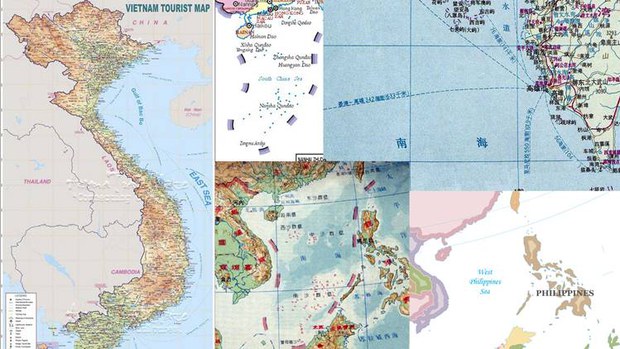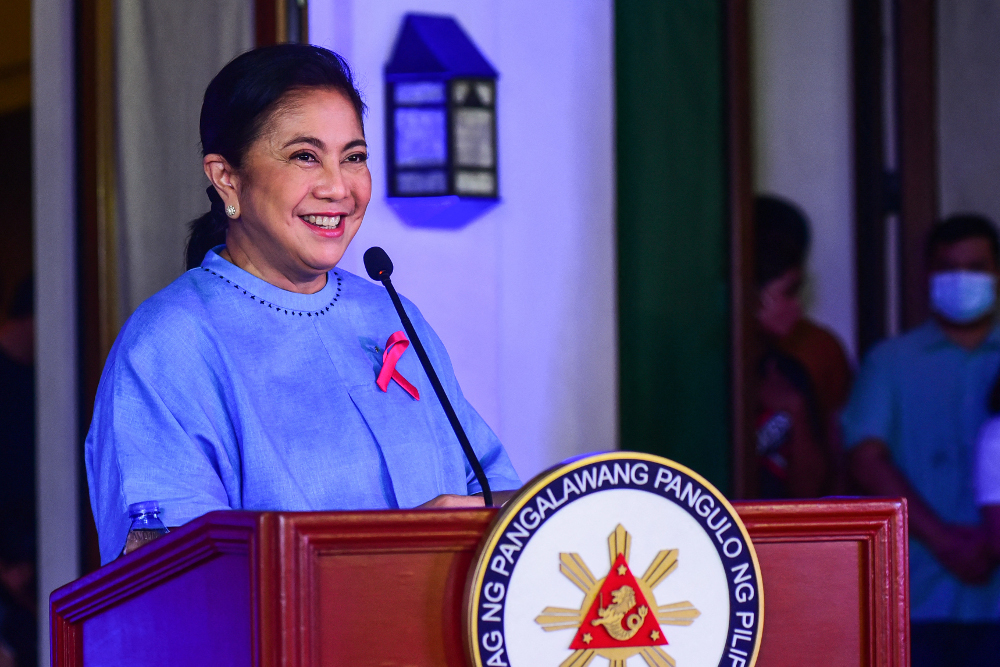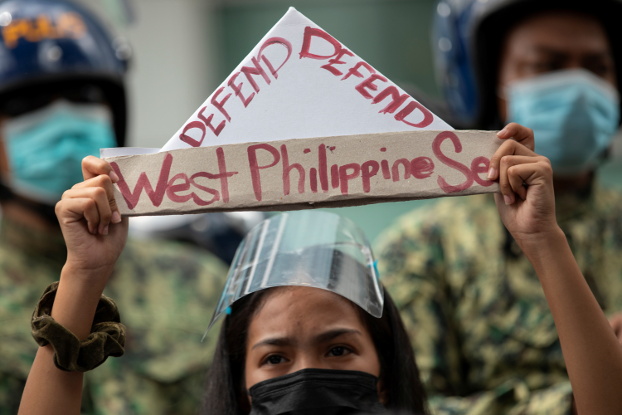In South China Sea, Even the Name is Disputed
2022.02.07
 A collection of maps describe how different countries refer to the disputed South China Sea.
A collection of maps describe how different countries refer to the disputed South China Sea.
What’s in a name? When it comes to the South China Sea, with its tangle of competing territorial and maritime claims, more than you might think.
Leni Robredo, Philippine vice president and presidential hopeful, learned that last week when she drew criticism for using “South China Sea” instead of the local, officially endorsed name, “West Philippine Sea.”
“Whoa, South China Sea???” – one person tweeted.
“Wait! Did she just call it ‘South China Sea’ instead of West Philippine Sea? Basic terms, mam!” – another posted.
Supporters of rival candidates in the May 9 election jumped on Robredo’s slip during an interview with a local radio station. The reaction points to one of the less talked-about, but fundamental matters of contention when it comes to the South China Sea where nations don’t just have disputes about who owns what, but about what to call it.
The Philippines isn’t the only claimant state that uses its own name for at least part of the vast waters stretching over 3.5 million square km (1.35 million square miles) from the Indochinese Peninsula to Luzon Island.
Vietnam calls it the “East Sea.” In China, it’s referred to as the “South Sea” – the source of the anglicized name, “South China Sea.”
Some people in the region are advocating a new name – the “Southeast Asia Sea.”

One sea, different names
Disputes among nations over naming, which extends to the myriad reefs and islets scattered across the South China Sea, are perhaps inevitable.
Brunei, China, Malaysia, the Philippines, Taiwan and Vietnam all claim parts of the sea. China draws a nine-dash line to claim “historical rights” to almost 90 percent of it, which overlaps with the exclusive economic zone (EEZ) of another nation – Indonesia.
Although “South China Sea” has near universal acceptance, use of preferred names among claimant nations is deeply rooted.
“In ancient times, names often came from the geographic locations,” said Nguyen Nha, a Vietnamese historian. “Vietnamese people have been calling the East Sea for thousands of years and the name is embedded in our folk culture.”
“There’s many traditional sayings that contain ‘the East Sea’, like, ‘A harmonious couple of husband and wife is capable of draining dry the East Sea,’ meaning they can achieve anything they wish to do,” Nha said.
In fact, “the East Sea” has become virtually sacrosanct and the only acceptable version in Vietnamese domestic media and political literature alike.
In the Philippines, the “West Philippine Sea” has official endorsement. In 2012, then-President Benigno Aquino III officially renamed the part of the South China Sea within the nation’s EEZ.
Manila then submitted an administrative order and an official map to the United Nations.
The Administrative Order No. 29 (2012) stipulates that the West Philippine Sea includes “the Luzon Sea as well as the waters around within the adjacent to the Kalayaan Island Group and Bajo de Masinloc, also known as Scarborough Shoal.”
“This was a very important step, clarifying which portions of the sea were ours,” said Celia Lamkin, founder and global chairwoman of The National Youth Movement for West Philippine Sea.
“I was so happy, the new name brought us some sense of ownership,” she said.
Lamkin organized an essay contest that attracted hundreds of participants a few months later.
“I have the urge to promote the new name everywhere I go,” said Lamkin, adding: “I use the name in every paper that our organization produces, as well as at international conferences. When I have to use ‘South China Sea,’ I put ‘West Philippine’ after ‘China’ to make it ‘South China West Philippine Sea!’”
The author of a book on the Philippines’ legal case against China brought to the Permanent Court of Arbitration in 2016 discussed the name’s importance. The court in 2016 rejected most of China’s claims in the South China Sea but Beijing has not accepted the ruling, calling it “null and void.”
“For the Philippines, it is important to call parts of the South China Sea as ‘West Philippine Sea’ and to raise awareness about the name,” said journalist Marites Vitug, author of “Rock Solid.”
Vitug quoted a former congressman, Walden Bello, as saying the name “West Philippine Sea” could serve as “a psychological blow to China."
“If you keep on calling a site the ‘South China Sea,’ it subliminally connotes some kind of 'possession' by China. ... For us, Filipinos calling the area the ‘West Philippine Sea’ marks a subliminal paradigm change,” Bello reportedly said.
Vitug says that since the Philippine name “only concerns our share of the sea within our EEZ, it shouldn’t be a contentious issue.”
“Perhaps it is contentious when it comes to official communiques of the ASEAN (Association of Southeast Asian Nations). But this doesn't mean that we cannot continue to use [West Philippine Sea],” she said.
Indonesia – although it maintains it is not a party in the territorial disputes over the South China Sea – followed the Philippines’ action by renaming the northern part of its EEZ “North Natuna Sea.”

Emotional values
Some analysts argue that even though the name “West Philippine Sea” was not given to the entire South China Sea, it does have political significance and should not be internationally recognized.
“In the 1898 Treaty of Paris used to delineate the islands of the Philippines as transferred to the U.S. on paper, it did not form a territorial sea claim or boundary until after independence,” said Mark Hoskin, a lecturer on China’s maritime history and law at China Foreign Affairs University in Beijing.
Therefore, in his opinion the new name “has no place or meaning in history, legally or otherwise.”
“Chinese people have always referred to the South China Sea as the ‘South Sea,’ ‘Nan Hai,’ one of the ‘four seas’ (North, South, East and West seas). They are very emotional about the name and would defend its use wherever possible,” said Hoskin.
“Historically, they have had domestic and international acceptance of it for centuries, so it is reasonable in my view for them to want to keep it as the international name for the sea.”
But “South China Sea,” the Anglicized version of Chinese “Nan Hai,” lacks “neutrality and inclusivity,” according to Le Trung Tinh, a Vietnamese scholar.
He said it would be more appropriate to call it the “Southeast Asia Sea” instead since Southeast Asian countries encompass almost the entire South China Sea.
Southeast Asia’s total coastline is about 130,000 km (81,250 miles), whereas southern China’s coastline measures only about 2,800 km (1,750 miles).
“The name ‘Southeast Asia Sea’ is more acceptable for countries in the region and also more accurate, in terms of the geography,” Tinh said.
In 2011, a change.org campaign organized by a Vietnamese overseas group to promote the name change received more than 40,000 signatures in the first couple of months.
Since then, a total of nearly 93,000 people have signed the petition addressed to world leaders and leaders of Southeast Asian countries. But a change will not be easy to achieve.
Tinh, who is also one of the signatories, said the campaigners should not give up.
“We should be persistent, patient and thinking long term,” he said, pointing out that a personal campaign that he waged single handedly to replace the word “Chinese New Year” with “Lunar New Year” in the U.K. where he lives, has borne some fruit.
“The other day I received an email from my son’s school talking about ‘Chinese New Year’ celebrations. I immediately emailed them back asking to change the title,” Tinh said.
“And you know what? After a few email exchanges they changed.”







